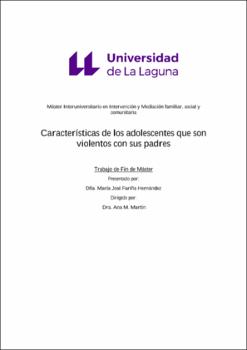Características de los adolescentes que son violentos con sus padres
Fecha
2019Resumen
La violencia filioparental (VFP) se ha convertido en un problema social del cual se
encuentran referencias desde el siglo XX, sin embargo, aún existe poca investigaciones
concluyentes. El objetivo de este estudio es investigar sobre el perfil psicosocial de
menores de población normal que informan haber llevado a cabo conductas de VFP, a
través de una serie de variables estudiadas previamente en este ámbito como son el sexo,
la enfermedad mental, la edad, el consumo de droga, la exposición a la violencia, el
autoconcepto, la justificación a la violencia y las técnicas de resolución de conflictos
maritales y de pareja. La muestra se compone por un total de 117 estudiantes de
Bachillerato, que debían contestar a un cuestionario, las edades se comprendían entre 16
y 19 años, 50,4% son chicas y 49,6% chicos. Los resultados señalaron que hay un mayor
número de participantes que afirman haber cometido alguna conducta de VFP que los que
no lo hicieron, fluctuando desde 1,7% en la conducta de escupir, hasta un 57,3% en la de
insultar. No se encontraron diferencias significativas entre el sexo, la enfermedad mental,
la edad, el curso y el tipo de familiar. Losresultados revelaron que las variables estudiadas
eran útiles para distinguir entre los dos grupos, per sólo para las conductas de VFP por
separado. Las discusiones plantean seguir indagando en este problema social centrando
los estudios no sólo en las características de los menores sino también de sus padres para
entender mejor las razones por las que se comenten las conductas de VFP. Child to parent violence (CPV) has become a social problem of which references are
found since the 20th century, however, there is still little conclusive research. The aim of
this study is to investigate the psychosocial profile of underage from normal population
who report having carried out CPV, through a series of variables previously studied in
this area such as sex, mental illness , drug abuse, exposure to violence, self-concept,
justification to violence and techniques for resolving marital and couple conflicts. The
sample is composed of a total of 117 high school students, who had to answer a
questionnaire, from 16 to 19 years old, 50,4 % girls and 49,6% boys. The results indicated
that there is a greater number of participants who claim to have committed some CPV
behaviour than those who did not, ranging from 1.7% in spitting behaviour to 57.3% in
insulting behaviour. No significant differences were found between sex, mental illness,
4
age, course and family type. The results revealed that the variables studied were useful to
distinguish between the two groups, but only for the CPV behaviours separately. The
discussions suggest continuing to investigate this social problem, focusing the studies not
only on the characteristics of the minors, but also on their parents to better understand the
reasons why CPV behaviours are being discussed.





